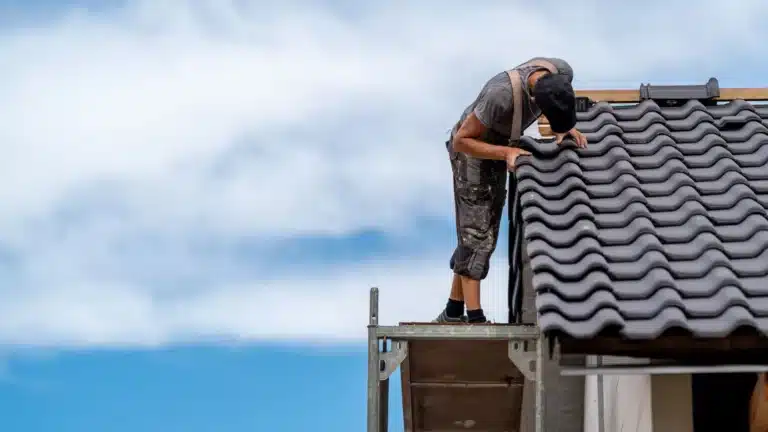Table of Contents
Roof replacement is one of the biggest costs a homeowner incurs. Often, it can run into five figures. For some homeowners, the necessity of urgent repair, as indicated by severe leaks or other water damage disasters, only adds to financial worries — especially if they have not budgeted for home repairs. Let’s figure out how to pay for a roof with no money.
How to Pay for a Roof With no Money
It becomes important to be aware of the financial options available during such times to have a solid plan in mind. In addition, there are many financial assistance options, including insurance claims and government grants. Read on to understand these options in detail.
Understanding the Costs of Roof Replacement
While understanding how to pay for a roof with no money, it is crucial to know that not every roof replacement is the same. Roofing prices are determined by factors like the size of a roof, the type of material used for installation, and regional fluctuations in pricing.
Asphalt shingles are usually among the cheapest materials, making them more affordable. Still, those other higher-end choices (like metal or slate) will cost much more.
Labor fees can be 60% of the total expense alone, making it an unreasonable cost for most homeowners.
Because of this high expense, you must consider every means possible to pay for a new roof. Research these factors to be better prepared when comparing quotes, and pay closer attention to budget-friendly materials if you need to obtain funding soon.
Also read: Is a New Roof Tax Deductible?
Exploring Homeowners Insurance Coverage
It doesn’t come cheap, but homeowners’ insurance can be your best friend when it comes to repairing or replacing a roof. Policies usually cover repairs in unpredictable events like storms, hail damage, or fire. However, insurers may not cover the cost of such damage if caused by wear and tear or neglect. Homeowners must photograph and document the damage extensively to file a claim, often presenting inspection reports or estimates from roofing professionals.
For natural disasters, insurers may categorize property damage as resulting from an ‘Act of God’, and should, therefore, not be covered depending on the specific deduction. You also need to act quickly.
Blocks of water struts are mapped out over many years, and if you take too long to file a claim after an event, it might be considered internal negligence.
Read your policy, contact your insurer to discuss details, and obtain an independent inspection if you believe there is accompanying damage.
Secondly, when insurance does not cover the loss completely, some policies will pay your home repair costs or a portion of them while you investigate other options for funding.
Also read: Earthquake-proof your finances and prepare for natural disasters
Applying for Government Grants and Assistance Programs
Some government programs offer assistance to homeowners facing immediate repairs, such as roof replacements. Operating at the federal, state, and local levels, these programs target low-income families and households influenced by natural catastrophes.
The U.S. Department of Agriculture (USDA) has a special program through Rural Development to help people purchase homes in rural areas even if their income is low or moderate. The program allows for grants plus low-interest loans. The Department of Housing and Urban Development (HUD) also offers assistance with resources such as the Section 504 Home Repair program, FHA Title I Loan Program, or Community Development Block Grant (CDBG) program.
Typically, to qualify for them, a person needs to be under certain income thresholds, among other requirements.
Additional funding may be available, especially for those with disabilities or specific needs, from programs such as the Weatherization Assistance Program (WAP). This program provides grants to make some homes more energy-efficient by providing money for roof repairs.
Visiting local government offices or nonprofit organizations can provide a lot of information about grants, making it easier to apply for funds.
Using Personal Loans and Home Improvement Loans
Both personal and home improvement loans can provide a simple way to pay for roof replacements, especially if you have little in the bank or no equity in your existing house.
Most banks, credit unions, and online lenders offer unsecured personal loans. These do not require collateral and usually feature fixed interest rates with terms ranging from (1 to 7 years or according to the lender’s policy).
The biggest benefit of personal loans is they are an option for everyone: the lenders can work with all types of credit. Home improvement loans (usually for projects with a higher cost and lower interest rates) are designed by lenders specifically to help homeowners who wish or need cosmetic work done on their homes. Therefore, a personal loan usually requires good credit scores and whether you have significant income. You can compare rates, fees, and loan terms from various lenders to find an affordable installment loan with monthly payments that are easy to budget.
Also read: Home Improvement Loans: How to Get the Best One
Considering Home Equity Loans and HELOCs
Homeowners with enough home equity can consider home equity loans and Home Equity Lines of Credit (HELOCs).
A home equity loan is a lump-sum loan based on your property levels of money, usually with a fixed interest rate, so that you can create liquidity more easily in the repayment process. This is in contrast to a HELOC, which operates as though it effectively provides homeowners with a credit card for what they owe on roof repairs; you borrow precisely how much money you need and repay over time.
Both financing options have lower interest rates than personal loans since the home is backed by collateral. However, defaulting on these loans can lead to foreclosure. Weigh the risks carefully.
And yet, for the borrower who knows they can pay back these loans, it may be just what you need to afford a roof replacement with relatively low monthly payments and tax-pays off interest.
Taking Advantage of Roofing Company Financing
Several roofing companies provide financing programs directly to homeowners, which can allow them to obtain a roof repair in manageable monthly installments. Many of these companies work with third-party lenders that allow deferred payment plans, zero-interest loans, or extended repayment terms. A credit check is required for some plans, whereas others are available to homeowners with limited credit histories.
If the roofing company offers in-house financing, you can negotiate based on your financial situation. Others might give discounts or rebates for specific payment plans you choose to reduce the pain.
Exploring Crowdfunding and Community Assistance
Crowdfunding is becoming an option for raising funds for big expenses such as home-related repairs. Platforms such as GoFundMe and Fundly allow homeowners to share their stories and seek donations to fund a new roof from friends, family members, or even strangers. In order to achieve success, a homeowner needs to be able to market the campaign and leverage a supportive community.
If you are a homeowner involved in the community, contact local organizations, religious institutions, or charities.
A few nonprofits offer grants or volunteer-powered repair programs.
Some disaster relief organizations—like the American Red Cross or Habitat for Humanity—might be able to help in cases where natural disasters have affected a roof. This can be done through community assistance along with other financing options, which will help decrease the costs and relieve you of the huge burden of expensive roof repair.
Tips for Negotiating with Roofing Contractors
At the very least, working out a deal with roofing companies could save you hundreds. Since prices can vary widely, homeowners might want to obtain several quotes from contractors. Homeowners tend to save money by comparing quotes and talking about budget constraints in advance.
While it is less common for skilled labor, some contractors might extend discounts if you refer their services to others — or hire them in the interim season when the demand drops. Further, options for bulk purchasing or requests for a discount on materials can help lower costs. A contractor who knows you have a limited budget offers compromises to make it work, such as recommending different materials or payment schedules.
How Beem Can Help You Manage Home Improvement Costs
Beem can help homeowners manage expenses, save money for repairs, and explore financing options offered specifically on homeowners’ behalf.
Homeowners make wise decisions when guided by Beem. Download the app here.
Conclusion
Even if a homeowner does not have cash on hand to cover expenditures like roof repairs, there are several ways in which necessary funds can be sourced. Right from insurance claims and government grants to loans (both private & personal) or even crowdfunding, there are many ways to learn how to pay for a roof with no money.
With careful planning and the right approach, homeowners can replace or repair their roofs without paying a large upfront cost.
Being resilient and open to exploring alternative funding sources means you can protect the value of your home without exposing yourself to undue financial hardship.
FAQs on How to Pay for a Roof with No Money
Can homeowners insurance cover the cost of a new roof?
Homeowners insurance can cover a new roof, but it usually will do so only if the damage is related to covered events (like storms, fires, and hail). Damage from normal wear and tear may not be covered by insurers, so it is important to review the specifics of your policy while discussing coverage with an insurance provider.
What government programs are available to help pay for a roof?
There are many government programs that offer different forms of financial support to fix the roof, mainly for low-income homeowners. An eligible homeowner may receive grants or low-interest loans through programs such as the USDA Rural Development Program, HUD’s Section 504 Home Repair program, and the Weatherization Assistance Program. State and local programs: Depending on where you live, these may also be available.
How do I apply for a home improvement loan?
To seek out a loan for home improvement, begin by researching lenders like banks, credit unions, and online platforms in areas like the interest you will be charged, any fees there may be, and the loan terms to ensure it is right for your situation. They also have a reasonably high credit score requirement and income documentation, so you must gather some documents before applying. After your application is accepted, you can use the loan for roof repair or other home enhancements.















































